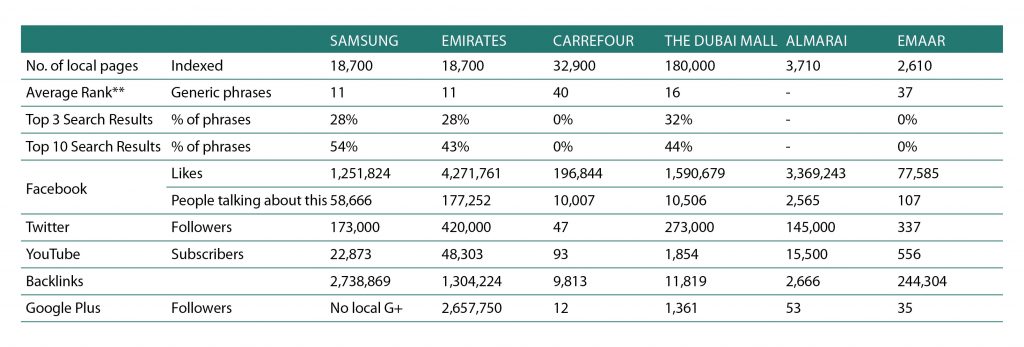The growth of the digital medium, including social and mobile, combined with the increasing consumption of online video in the region, has led marketers to complement traditional marketing with content marketing. “Brands are now challenged with evolving their strategies to not only create the volume of content required to satisfy consumer appetite, but to also ensure it remains engaging and not just a commodity,” says Lee Mancini, managing director of search-optimized content marketing agency, Sekari. “With all 2015 forecasts suggesting brands are looking to increase their digital marketing spending over the coming months, the spotlight is on online marketers to implement strategies that deliver high return on investment (ROI).”
With this in mind, Communicate teamed up with Sekari to look at the brands that are effectively using localized content marketing strategies in the region.
Methodology
“We have evaluated some of the region’s leading brands to understand how they are using content specifically designed for the region and how this translates to popularity or visibility,” says Mancini. An assessment criterion was constructed to review brands that stand out. Sekari objectively analyzed varied sources of the brands’ online efforts, including volume of dedicated local content and search visibility and social media localization with platforms such as Facebook, Twitter and YouTube. The agency also gave a more subjective overview to the brands’ content quality, which took into account originality and creativity, as well as the volume of links to the domain, giving an indication of the circle of influence.
This study looks at the local content performance of selected brands that appeared in YouGov’s Annual BrandIndex Buzz Rankings for 2014. Sekari’s data reviews local UAE domains instead of global domains and focuses on the local visibility on Google.ae.
The top six contenders
In no particular order, we look at how the six contenders fared.
Samsung
The study found that Samsung gets users intrigued about its products through teasers targeted to different consumer segments. The brand’s mobile category is specifically aimed to the youth, through content that they would find appealing, such as selfies and the like. Another plus for the brand it that it communicates through localized, Arabia-targeted social media products for its mobile category, indicating the value of this particular class in a region where 97 percent in the UAE and 96 percent in KSA alone, use mobile phones, according to Google’s Consumer Barometer. The brand also has Gulf-targeted social media pages, covering a broader range of its product offerings. Samsung’s online visibility scores high – second to Emirates – within Google.ae, with the highest backlinks amongst the brands surveyed. Its high visibility within Google.ae also indicates the high quality of its content that has been shared, as well as adopted – and hence, deemed useful – by other sites citing its content.
Emirates
Of all the brands surveyed, Emirates ranked highest in visibility for its content with search engine results in Google.ae, ranking in the Top three search results for 28 percent of generic ‘flight’ phrases. The Emirates website not only functions as a direct sales channel, but also tries to communicate the entire Emirates experience with dedicated sections discussing every detail from the fleet to the cabin features, explains Mancini. Moreover, the content includes a lot of cross-referencing between consumer demographics – from child passengers to frequent flyers. With the highest number of fans across Facebook, Twitter, YouTube and Google Plus, Emirates clearly makes the most out of its social platforms. However, since the brand does not segment its platforms regionally, it is difficult to compare and draw a fair analysis of its ranking versus other global brands in the study.
Carrefour
Carrefour, which is also seen as the No. 1 most authentic brand in the UAE, is naturally one of the most well known brands in the region, yet it lags behind in terms of its online presence. Despite a good volume of content on its website, it fails to get ranked for generic terms anywhere near page three. This goes to show that the content is not search optimized and hence deemed relatively not useful, as the number of links to the site is extremely low, explains Mancini. “The website’s format is such that it simply lists categories of its store inventory, rather than weaving a story or relating its products to its consumers’ lifestyle.” Surprisingly, Carrefour still manages to maintain a good volume of fans on Facebook as it localizes its pages by countries: the UAE, KSA and Jordan. The brand has some good content on its website, such as recipes, and “it could really make more use of this area on its website by using more magazine-type” content – something Spinneys has managed to execute extremely well, says Mancini.
The Dubai Mall
The Dubai Mall website feels more like a consumer lifestyle magazine. It is up to date with the latest events and offers, catering to – and attracting – all types of consumers from the fashion-conscious shoppers to the ones just looking for some dining and entertainment. By default, this helps its search visibility. The sheer volume of content on the site – approximately 180,000 pages – and the relevancy of all the content means that The Dubai Mall achieves the highest visibility in terms of volume amongst Google.ae’s top three rankings. However, it lags far behind on YouTube, with its last video update being two months ago, at the time of the study in February. Just the volume of events and in-mall activity provides The Dubai Mall a great opportunity to communicate the “mall experience” and increase the “visual richness” of the consumer experience, suggests Mancini.
Almarai
Almarai’s website seems to immediately resonate with a business-to-business (B2B) audience. Despite a large rotating banner with consumer products, its main content focuses on its corporate news and a live feed of its share price. Unsurprisingly then, this purely local brand struggles to achieve any visibility within Google.ae for generic terms relating to its products, as its product pages are limited in terms of content. “Almarai could take the opportunity to build on this by building silos of consumer content around their food types and try and resonate with the lifestyles of its audience segments – from families to health-conscious ‘foodies’,” advises Mancini. Interestingly, despite its poor performance in search visibility, the company has generated a large fan base on Facebook, second only to aviation giant, Emirates, in Sekari’s study.
Emaar
The Dubai Mall’s parent company, property development firm Emaar’s website is on the same line as that of The Dubai Mall with a lifestyle magazine feel. While the website content targets different types of consumers, from prospective homeowners to investors, it has the lowest volume of pages in Sekari’s study. As a consequence, the brand suffers in terms of visibility within Google.ae, ranking on average at No. 37, way back on the third page for generic “property” search queries. In terms of rich media, Emaar has a large collection of video content on YouTube and uses its channel to share episodes of the CNN series, One Squared, sponsored by Emaar. “However, with only 558 channel subscribers, Emaar perhaps could be doing more to attract and engage its audience with more property or Dubai-specific coverage,” says Mancini. Currently, engagement with off-site content is rather low with small fan bases on its social media platforms.
How content were we?
Commenting on whether this means that content marketing is truly alive and well in the region, Mancini says that although the study found examples of content-led strategies, it “could not establish how and if the content was mapped to the company’s sales cycle”. Also, there were some inconsistencies across the brands, as evidenced by certain labels, such as Carrefour and Emaar, that had good content on their website but ranked low in terms of search visibility for lack or proper content optimization. “We also noticed an indirect correlation with respect to social media fan base versus actual website content,” says Mancini. For instance, Almarai has a huge number of Facebook fans but it does not utilize this successful social content on its own website to draw consumers in.
While content marketing does require a fair bit of trial and error, according to Mancini, “it’s easy to ‘fire and forget’ and think your job is done when your content is published on your site”. But measuring the reach and performance of content after it has been published and tracking its progress to set benchmarks, is what’s important. And this is where most content marketers go wrong – before they can even begin to get it right.







